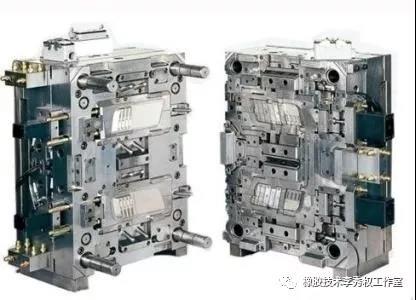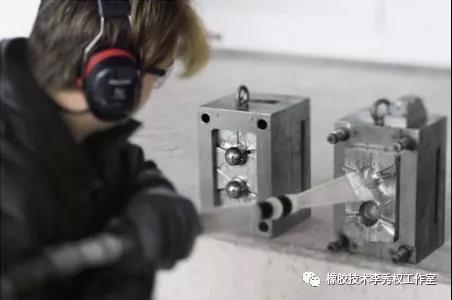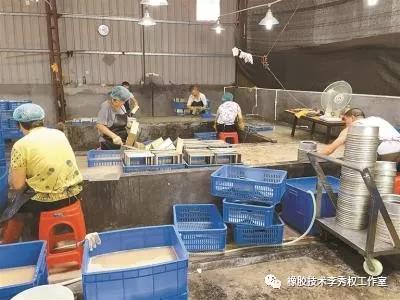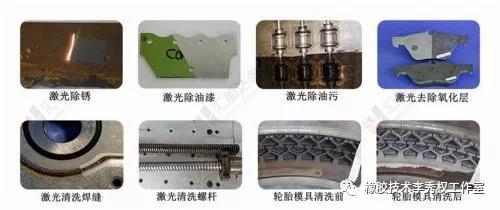Maintenance and cleaning of rubber molds
Release time:
2018-08-13
Pollution erosion on the surface of the rubber cavity The pollution erosion on the surface of the cavity is mainly manifested in the appearance of stains and moire, the agglomeration of pollutants and the corrosion of the cavity. The influencing factors are mainly related to the composition of the compound formula, vulcanization conditions and environment, mold material and processing. Natural rubber contains non-rubber hydrocarbon substances such as lipids, proteins and inorganic salts, which are most likely to contaminate the mold cavity during vulcanization. Halogen-containing rubber of synthetic rubber will produce halogen compounds during the vulcanization reaction to cause contamination of the mold cavity. For example, chlorine and HCl will be produced during the vulcanization of chloroprene rubber to erode the mold cavity. HF will be produced during the vulcanization of fluororubber to corrode the mold cavity. In the formula

Pollution Erosion on the Surface of Rubber Mold Cavity
The pollution erosion of the cavity surface is mainly manifested in the appearance of stains and moire, pollutant agglomeration and cavity corrosion. The influencing factors are mainly related to the composition of the compound formula, vulcanization conditions and environment, mold material and processing.
Natural rubber contains non-rubber hydrocarbon substances such as lipids, proteins and inorganic salts, which are most likely to contaminate the mold cavity during vulcanization. Halogen-containing rubber of synthetic rubber will produce halogen compounds during vulcanization reaction to cause contamination of the mold cavity. For example, chlorine and HCl will corrode the mold cavity during vulcanization of chloroprene rubber; HF will corrode the mold cavity during vulcanization of fluororubber, and acid absorbent must be added to the formula. Emulsions and catalysts in synthetic rubber can also cause pollution. The contamination of nitrile rubber increases with the increase of acrylonitrile content.
Sulfur, zinc oxide, polyphenols (such as bisphenol A), diamines, and accelerators such as TMTD and diphenylguanidine in the vulcanization system will cause pollution.
Others, such as softeners and fillers, can cause moire on the surface of the mold cavity. The better the compensation of carbon black, the lighter the pollution.
In the vulcanization process, due to the existence of thermal oxygen aging, sulfur, peroxide and other free radicals or ionic groups in the active state contact with the metal surface to form pollution, so the longer the vulcanization time or the higher the vulcanization temperature, the more easy to produce pollution, the more pollutants. At the same time, the humidity and dust of the vulcanization environment also affect the pollution of the mold cavity.
Mold material if the use of low carbon steel is easy to pollution, and carbon mold steel pollution is lighter. The most commonly used mold cavity surface treatment is chrome plating and polishing treatment.
Mold cavity maintenance and cleaning

In order to block the contamination of the mold cavity and prolong its life, some maintenance measures are often taken, such as release agent and surface coating treatment.
Examples of the mold release agent include silicone-based, fluororesin-based, grease-based (animal oil-based, petroleum-based), surfactant-based (nonionic, anionic), polyvinyl alcohol, and some dusts. Among them, polysiloxane and fluorine resin have better effects, but the price is higher. Other types of release agents should be reasonably selected according to the surface size and surface requirements of glue and products, as well as the mold material, because the release agent will also pollute the mold cavity.
Surface coating techniques include surface polytetrafluoroethylene (PTFE) treatment and PTFE-containing nickel-phosphorus electroless agent surface electroless plating methods. It is reported that Ni-P-PTFE chemical coating can greatly improve the corrosion resistance of the mold cavity. Due to the inclusion of PTFE, the self-lubricating and release properties are improved, and the mold release is very easy. It is suitable for peroxide or amine and bisphenol vulcanization system. The rubber compound, but not suitable for sulfur vulcanization system, because sulfur is easy to chemically react with Ni, resulting in mold cavity pollution.
Maintenance measures only to delay or improve the degree of contamination of the mold cavity, and can not completely prevent pollution, so the mold after a certain period of time, should be cleaned to remove surface contaminants. Can be divided into physical cleaning and chemical cleaning methods.
(1) Grinding method
The surface of the mold cavity is ground with very small particle size (1~6 μm) carborundum, and then polished with fine abrasive. Optional commercial grinding paste. This method will affect the dimensional accuracy of the finished product.
(2) Injection method
The jet machine with a certain pressure and speed of air, entrainment of the spray material (glass beads or dry ice particles) to the cavity surface of the mold, the dirt layer washed away. If the glass bead injection mold should be placed in a sealed chamber, glass beads can be recycled. If dry ice particles are sprayed, the low temperature of dry ice makes the dirt on the surface of the mold cavity freeze to embrittlement and crack, and the dry ice vaporizes instantly, and its volume expands nearly 800 times, thus washing the dirt away from the surface. The latter can be decontaminated on the production line, does not affect production, does not damage the mold cavity, does not produce secondary pollution, in line with environmental protection requirements, but the cost is higher.
(3) Alkali washing method

Lye can remove the mold cavity surface grease contamination. Several alkalis are used together, such as caustic soda, sodium bicarbonate, sodium silicate, etc., are prepared into aqueous solution and heated, the mold is placed in an alkali bath to soak for 30min or several hours, and then rinsed and wiped dry with clean water. This method belongs to chemical cleaning method.
(4) Ultrasonic cleaning
The ultrasonic cleaning effect is better, the labor intensity is low, the working environment is improved, and there is no damage to the mold cavity. Its working principle is that high-intensity and high-frequency ultrasonic waves produce cavitation in the cleaning solution, causing thousands of extremely fine bubbles to peel off the pollutants from the mold cavity, which can effectively clean the dead corners in the mold cavity. The cleaning process is to use sodium hydroxide solution concentration of 180 m-3), heat up to 71~87 ℃, after the exclusion of gas (gas can absorb wave energy), by the ultrasonic transmitter for ultrasonic cleaning, and then use hot water antirust liquid cleaning, compressed air to dry the mold. Due to the application of sodium hydroxide lye, this method is a comprehensive cleaning of physical and chemical methods.
(5) Mold cleaning glue cleaning (MCR)
The main component of MCR is a special compound composed of non-polluting polymers, substances that can physically and chemically interact with mold cavity pollutants (such as special drugs such as compounds containing amino and hydroxyl groups) and other compounding agents. The MCR is filled into the mold cavity, and the physical and chemical effects between the rubber compound and the surface of the mold cavity are produced through the vulcanization process to absorb and remove dirt, so as to achieve the purpose of mold washing. At home and abroad have a variety of MCR brand wash mold glue for selection. It is said that it can clean all kinds of molds, has strong detergency, does not erode the surface of the mold, and improves the cleanliness of the mold.
The maintenance and cleaning technology of the mold is developing continuously, and there are many cleaning methods, which should be selected according to the material, structure and geometric size, precision and smoothness, pollution degree, cleaning efficiency and secondary pollution of the mold.
(6) laser cleaning mold

There are many kinds of mold cleaning methods, such as mold cleaning machine, pickling, dry ice cleaning, sandblasting, etc. Laser cleaning is the latest cleaning method at present. It can clean injection molds, casting molds, food molds, glass bottle molds, etc. Small corners and trenches in the molds can be cleaned, as long as the laser can illuminate the places can be cleaned, this advantage avoids the disadvantages of traditional cleaning methods.
Key words:
Relevant Blog
Methods of bridge reinforcement
2018-08-13
Maintenance and cleaning of rubber molds
2018-08-13
Contact Us
Hotline:
+86-318-8885959
E-mail:
xiaoshoubu@hebeitaile.com
Address:
No.88, Industrial Street, North Industrial Base, Taocheng District, Hengshui City, Hebei Province
Website

Copyright © Hebei Taile Railway Equipment Co., Ltd



